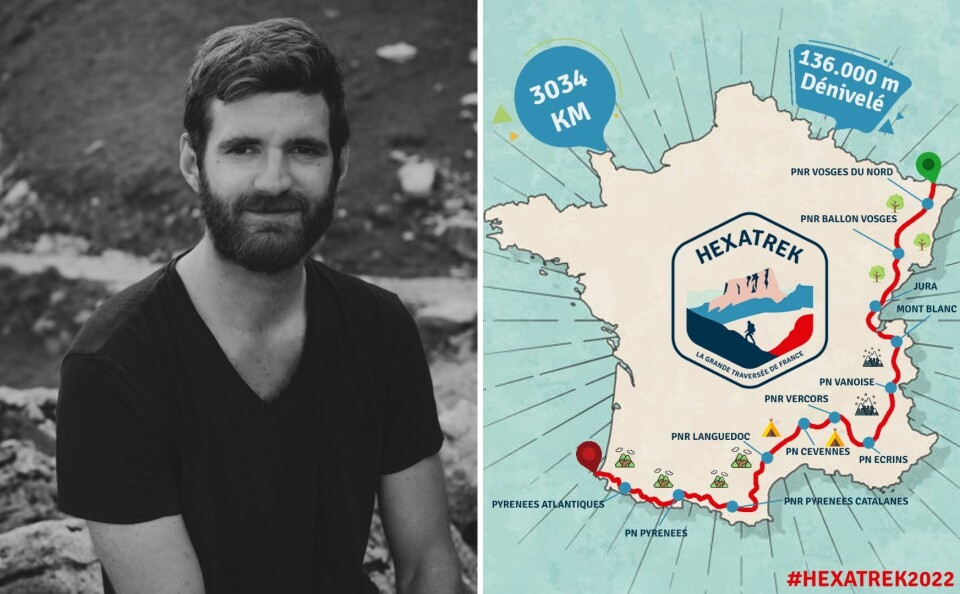-
Step back in time for some ‘dinosaur’ planting in your French garden
Captivated in the garden this month by one species of plant that dates back 200 million years, and another which is one of the oldest flowering plant families on the planet
-
Classic French recipe with an exotic twist: caramelised onion soup
A dish inspired by the travels of two Paris chefs
-
HPI final season: the end of a French TV phenomenon
Comedy-thriller starring Audrey Fleurot that gripped France airs final episodes
New 3,000km hiking trail takes trekkers across ‘hidden’ France
The mountain route runs from Germany to Spain - its creator explains why people are taking a break from life to walk the trail

An adventurer has developed a hiking trail which crosses France through its most breathtaking mountain ranges, from the Vosges in the north east to the Pyrenees in the south west.
The 3,000km HexaTrek includes 136,000 metres of elevation, and takes three to five months to complete.
Inspired by American trail
Founder Kevin Ginisty quit his big data job six years ago before travelling the length of New Zealand in a van and hitchhiking in Scandinavia.
The 32-year-old Frenchman, who lives in Chamonix, was above all inspired by the Pacific Crest Trail (PCT), tracing the entire west coast of the US, which he hiked on his way from Patagonia to Canada in 2020.
That trek included going 17 days without seeing another human. “I had lots of time to reflect on why we didn’t have a similar trail in Europe,” he said.
He was speaking to The Connexion over the phone from a restaurant somewhere near the Gorges du Tarn, 51 days into the inaugural hike, due to arrive at the German border in late October.
“There are not many large towns nearby, so we’re happy to find pizza, water, and a Coke,” he said, taking shelter from the afternoon heat.
People want to do big treks for personal reasons
His idea struck a chord – 200 people were hiking the route with him.
A crowdfunding campaign, which ended in October, raised more than €52,000, smashing the initial goal of €6,000.
“I thought I was the only one crazy enough to want to cross France by foot,” Mr Ginisty said.
Although the trail is divided into six stages, he said most people want to do the whole thing in one go, such is the spirit of the ‘thru-hike’, where backpackers complete treks like the PCT from one end to the other.
At least half the people on the inaugural hike had quit their jobs or taken a sabbatical, he said.
“They were mostly fed-up with their job, struggling to get over a relationship, or had experienced a family tragedy.”
The ages of those who set off in June range from 22 to 64.
While there is no climbing involved, it is no walk in the park, either. Most will average around 1,000 metres in elevation per day.
“The best physical preparation is to walk the first two weeks at your pace, as your muscles will develop automatically,” Mr Ginisty said.
Trail is no risk to nature
Critics say HexaTrek will bring more disturbance to the natural environment, a claim the creator rejects.
“Even on the GR10 (a trail in the Pyrenees), we saw maybe 100 people in a month. Few people do long hikes. On the other hand, lots come by car and walk for an hour.”
Read more: National parks in France warn visitors to respect flora and fauna
The trail also goes beyond the most popular destinations.
In the first month, they passed hikers from San Francisco, Germany and Belgium doing the trail in the opposite direction.
“They all said they would never have been to the trails in the centre of France if it wasn’t for HexaTrek,” Mr Ginisty said. “It’s a pleasure to see people discovering this part of France which has been slightly abandoned.”
Mobile app and signage guides trekkers
Because of snow risks, those wishing to commit to the whole trail are advised to depart between May 15 and June 1 if heading south, or between June 15 and 30 when travelling north.
The route is freely available as a GPX file which can be used with GPS apps and devices.
Much of the crowdfunding went towards creating the HexaTrek mobile app, which shows areas suitable for camping, shelters, water and resupply points along the way, as well as must-see villages and scenery.
The app costs €9.90 for each stage.
The money also allowed HexaTrek to become a non-profit association.
While hiking, Mr Ginisty placed signs every 10km.
Since HexaTrek connects 47 existing trails, hikers will mainly follow the red and white markers of the Grande Randonnée (GR) footpaths.
“We didn’t invent anything. We took what already existed because it was already incredible,” Mr Ginisty said.
“The important thing was to create a community, a name, and a sense of belonging.”
Related articles
New hiking trail follows historic transhumance routes of Provence
Hikers in France warned against building ‘cairns’ on trails and paths
Mayors ban pointed walking poles on fragile French coastal paths
























